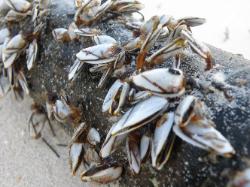

| La especie de hoy no se encuentra en peligro, ni es particularmente atractiva. Pero vamos a intentar hacer de esto una presentación semanal en vez de mensual, por lo que tendremos que incluir ejemplares menos emocionantes de vez en cuando. Sin embargo, intentaremos tener algo interesante que decir de cada especie mencionada. Y es así que hoy me encuentro compartiendoles a un percebe cuello de ganso, esos pequeños crustáceos que se adhieren a barcos o pedazos de madera. Nunca les había yo prestado atención antes, pero tras recibir este video de mi amiga Eva Estes, tuve que preguntarmen ¿que es eso? Me puse a investigar y aunque no estoy seguro de la especie ya que hay varias similares, definitivamente es del genero Lepas, y sospecho que se trata de Lepas anserifera. Independientemente, el motivo por el cual considero que vale la pena hablar de ellos, aparte de mostrarles este video, es su historia cultural. En la Europa Medieval, antes de que se supiera de migraciones animales, se creía que ciertos Gansos crecían a partir de estos percebes, ya que jamás se le veía poner huevos. De hecho, la Iglesia Católica consideraba a estos gansos como peces, y se permitía comerlo los viernes. En nuestros tiempos más ilustrados, los percebes son notorios en el reino animal por otro motivo. El estar anclado en el mismo lugar toda la vida presenta un reto interesante a la reproducción sexual, y los percebes (hay más de 1,000 especies) han desarrollado algunas estrategias curiosas para sobreponerse a esta limitante: sus genitales masculinos pueden medir hasta 8 veces lo que su cuerpo, lo cual los en los animales “mejor dotados” del planeta. |
Percebe Cuello de Ganso
Goose Baranacle
Lepes sp.
Goose Baranacle
Lepes sp.
| Today’s species is neither endangered, nor particularly attractive. But we are going to try to make this a weekly feature instead of a monthly one, so we’ll have to include some less exciting entries every now and then. However, we will strive to have something interesting to say about each species featured. And so today I’d like to present the Goose Barnacle. Yes, barnacles: those shells that stick to boats and driftwood. Like you, I’d never given them much thought. But then I received this fascinating video from a good friend of mine, Eva Estes- and I had to ask myself “what is that?”. After a bit of research I found out its called a Goose Barnacle. I’m not exactly sure what species it is, there are a couple in the Lepas genus which look very similar, but I’m leaning towards Lepas anserifera. It’s definitely some sort of Lepas. In any case, the reason I found them worth talking about, aside from sharing the video, is their cultural history. In mediaeval Europe, before they knew about such things as animal migrations, it was widely believed that certain geese- which were never seen laying eggs- grew out of these barnacles. In fact, the Catholic Church considered these geese a fish, and so the faithful were allowed to eat them on fridays. In our more enlightened times barnacles are notorious in the animal kingdom for another reason. Being anchored in place your whole life presents an interesting challenge to sexual reproduction, and barnacles (there are over 1,000 species) have developed some curious strategies to overcome this limitation: male genitalia can measure up to 8 times their body length, making them the most “well endowed” animals of all. |
| Photos and text by David Nuñez |
| Recomendamos estos libros sobre la Fauna de México. (Los nuestros son bilingues.) |
| To learn more about the Wildlife of Mexico, we recommend the following books. |















